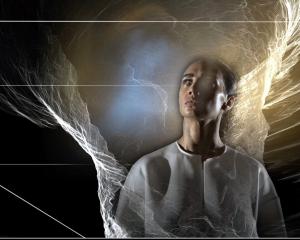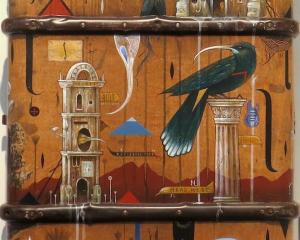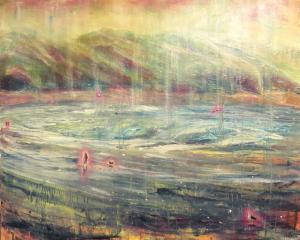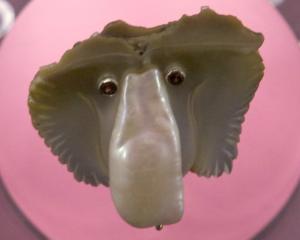Milford Galleries is home to two complementary exhibitions at the moment, by sculptor Neil Dawson and painter Mervyn Williams.
Dawson is well known for his masterful geometric sculptures, which he has made on both the monumental (as with Chalice, the massive inverted cone in Cathedral Square, Christchurch) and more intimate scale. The smaller pieces often take the form of convex wall hangings where repeated motifs are woven into complex patterns.
These latter works have, in recent times, often been created with their reverse sides painted in bright colours, so that the wall space behind the sculptures is filled with a warm glow, the silver (or, more correctly, coloured) linings of the exhibition's title. This creates a distinct shaded space behind the art, allowing it to float freely from the wall against which it hangs.
While he still uses rigorous geometry in his works, Dawson's more recent pieces explore softer lines. The bowl-like structure of the hypnotic Vortex draws the viewer to the eye of calm in the centre of its maelstrom. Nearby, Fibonacci bird flights create delicate calming spiral forms from the hard steel, and the reflected colours allow these flights to glide free from a backdrop of illusory rose-tinted clouds.
As with Neil Dawson's work, Mervyn Williams' art explores the nature of two-dimensional and three-dimensional art and the borderlines between the two.
Williams' startling work plays with the viewer's perception of the painted surface, presenting images which appear to be on loose, unstretched canvas. The canvases, however, are flat and taut, and by the artifice of paint, the artist has produced strong trompe l'oeil abstracts. Through the use of simple geometric patterns and an astute awareness of the play of light on folded material, Williams creates powerful illusory surfaces which seem to transcend the line between two and three-dimensional image.
In this latest display, Williams takes his abstractions one logical step further, presenting solid colour seemingly framed within the non-existent flaps of canvas. These flat areas seem to hang either in front of or behind the rest of the image. The use of bold saturated colour in these areas, extreme almost to the point of fluorescence in comparison with the deliberately muted surrounds, adds to this deception. The eye remains riveted to these coloured areas, causing other perceptual illusions to take place at the apparently shifting boundary between flat colour and rumpled grey.
The works are fascinating, entirely effective, and in their own austere way, very beautiful.
In ''Beachcoma'', Sam Thomas examines the quest to create a new world for one's self in an idyllic untouched paradise. Artists of all descriptions, from Gauguin to Stevenson to Brando, have travelled to the Pacific as a way of mentally renewing themselves, clearing their head so as to be at one with nature.
Even when physical travel has not taken place, artists have used the idea of a sandy haven as catharsis. In this expedition/exhibition, Thomas uses as a leaping-off point the struggles of pop music's Brian Wilson, who retreated into his own ''sand pit'' in order to renew himself, creating when he did so various thought experiments and eccentric designs.
Thomas has created ephemeral objects from driftwood and other items found while in the Cook Islands. He has thus formed his own place of experimentation and refuge, of which these items are signifiers, their exact meanings known by Thomas alone. Simultaneously, his works reference traditional art forms as re-created kitsch exotica for a tourist market. Again, there is a deliberate sense of a meaning which has been lost to the viewer during the process, in much the same way that a plastic tiki contains none of the mauri of a true cultural artefact.





![... we all become all of these things [installation view] (2025), by Megan Brady.](https://www.odt.co.nz/sites/default/files/styles/odt_landscape_small_related_stories/public/story/2025/03/1_we_all_become_all_of_thes.jpg?itok=nicA_yAm)


![Poipoia te Kākano [installation view]. Allison Beck, Megan Brady, Kate Stevens West, Jess...](https://www.odt.co.nz/sites/default/files/styles/odt_landscape_small_related_stories/public/story/2025/02/1_poipoia_te_k_kano.jpg?itok=ssJ8nxyx)



